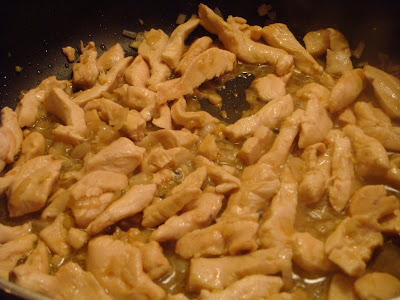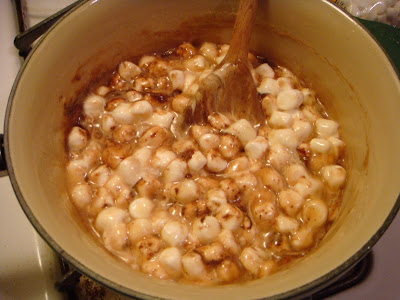
I received a
pasta maker and
ravioli attachment for Christmas. The time had come to unbox these and put them to work -- or as it turned out, put me to work.
For my first attempt, I wanted to stick with a regular egg pasta dough, no spinach or anything fancy, and I wanted to make some sort of meat filling. The pasta maker included recipes for the dough and a couple different fillings but not one I was in the mood for.
I searched around a bit for filling recipes but just wasn't finding any that struck my fancy. So I posted a
want ad on
Serious Eats and got some great ideas there (thank you to those who responded!). I finally chose
Tyler Florence's chicken marsala filling.
I read through the recipes for the filling and for the dough. The dough needed to rest for about 20 minutes, and the filling needed to cool before it could be used. Taking these things into account, I decided I would make the dough first to the point where it needed to rest, then make the filling and let it chill, and then go back to the dough. Cooking always requires this balance of time. You don't want to be sitting waiting for two things when you could be waiting on one and working on another.
Pasta Dough (adapted from Imperia recipe and
Williams-Sonoma Pasta)
There are many recipes out there for pasta dough. They all basically call for flour and eggs. Some, like the one I found in
Williams-Sonoma Pasta, also call for olive oil. I took the recipe that came with the pasta maker and the one from the Williams-Sonoma book and used ideas from both. The one that came with the pasta maker said I could put the flour and eggs in my KitchenAid and mix it on a low speed. It then said to moisten the dough with water if necessary. This is where I borrowed from the Williams-Sonoma recipe and moistened the dough with olive oil instead.
Ingredients
2 1/4 cups flour
3 eggs, lightly beaten
olive oil, as needed
Method
Combine eggs with 2 cups flour in bowl of electric mixer. Using paddle, on low speed, combine until dough comes together and is no longer sticky. Add more flour as necessary. If dough gets too dry, moisten with olive oil.

Knead dough by hand until it's smooth and not sticky. Wrap with plastic wrap and let sit about 20 minutes.

While the dough rested, I moved onto the filling as planned...
Chicken Marsala Ravioli Filling (from Tyler Florence)
Ingredients
8 ounces chicken breast, cut in strips
4 tablespoons olive oil, divided
1 shallot, chopped
1 garlic clove, chopped
1/4 cup Marsala wine or chicken broth
4 thin slices prosciutto, sliced
4 bay leaves
Fresh thyme and parsley leaves
2 tablespoons bread crumbs
2 tablespoons Parmesan cheese, grated, divided
Salt and pepper
1 egg
1/4 cup heavy cream
Directions
Brown chicken in 2 tablespoons of olive oil over medium-high heat. Add shallot and garlic. Deglaze with Marsala. Take pan away from heat source and flambe. Return pan to stove, flame will go out in about 1 minute. Add prosciutto and herbs. Sprinkle in bread crumbs and 1 tablespoon Parmesan. Drizzle in 1 tablespoon of olive oil to keep moist. Discard bay leaves. Pulse together all ingredients in a food processor. Add egg, cream, remaining Parmesan and olive oil. Pulse again. Chill before filling ravioli.
First, I made sure I had all my ingredients prepped and ready to go. Those cute little prep bowls are from Pampered Chef, and they really do make me feel quite pampered. Also, it's fun to just toss your ingredients into the pan as if you're cooking on the Food Network instead of in a little apartment kitchen. They held chopped garlic and shallots, grated cheese, breadcrumbs, and fresh thyme (I skipped the parsely). I also sliced the prosciutto and chicken, and with all of that done, I turned on the stove and placed a pan with oil on the burner. Now, let the cooking begin!

Step 1 - Brown the chicken in the olive oil.

Step 2 - Add the shallot and garlic. And for me, deglaze with marsala and flambe was simply add marsala. I wasn't about to try lighting alcohol on fire today. Maybe another day.

Step 3 - Add prosciutto and herbs.

Step 4 - Add cheese and breadcrumbs. I think I might go a little less on the breadcrumbs next time. While a runny mixture is a definite no, the filling seemed a little on the dry side, even with the addition of olive oil.

Step 5 - Remove the bay leaves, put the rest in the food processor, and process away. I did this in batches, but once everything was ground up, it could all fit in the processor bowl at the same time. And I was able to add in the remaining ingredients (egg, heavy cream, parmesan, and olive oil).
Step 6 - Cool the filling and then put it in the fridge to chill further.

With the filling all set to go, I could return to pasta making. This didn't turn out to be as difficult as I thought it would, once I got the hang of it. I had to divide the dough ball into pieces, take each piece and run it through the pasta machine several times -- starting with the thickest setting and then going thinner and thinner, until I got to the second-thinnest setting, which is recommended for meat-filled ravioli.



With the pasta sheets laid out and ready to go, it was time to put the ravioli attachment on. Because the sheets might spread out farther than the width of the ravioli attachment, it comes with a cutter that is as wide as the opening. I had to cut each sheet of pasta with this before I could feed it through the machine.
I folded the pasta sheet down the middle, making a soft crease. The crease should go into the middle of the machine. Then I simply followed the directions to place about 2 1/2 tablespoons of filling into the middle of the pasta sheet.

I slowly turned the crank, fixing the alignment of the pasta and smoothing and adding to the filling as necessary. And the machine sealed off perfect little ravioli packets. I have to admit I ruined one whole sheet because it caught in the machine. You have to be careful that no little bits of pasta or filling get stuck to the machine because it can cause your next batch to jam or tear.
I laid each set of ravioli on a sheet of floured parchment and waited the recommended 10 minutes before separating them.

After that I added them to a pot of boiling water. They really do cook quite quickly. Within minutes the ravioli were floating to the top of the pot, a sign they are ready.

One small afterthought was the sauce. I didn't want to use a tomato sauce with the marsala filling, so I threw together a quick marsala sauce, consisting of heavy cream, marsala wine, lemon juice, and salt and pepper. I thickened this with a little flour. I really should have made a roux, but I was in too much of a hurry to taste my little ravioli creations, so we did have a few flour clumps in the sauce.


Even though this meal took a lot of work, it was worth it, and I highly recommend making your own pasta. It was delicious, and the texture is nicer than storebought. Plus, with your own filling, you know what's going into it. You don't have to worry about any preservatives or other additives.
The ravioli outsides were chewy and tender, and the insides were a teeny bit dry, but the cream sauce helped to balance that. I can't wait to make some other pastas and raviolis. I do have a whole book full of ideas to get through!















































